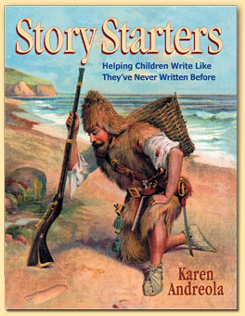Charlotte Mason fans should love this volume of story starters designed to stimulate creative writing in response to a partially written story and one or more companion illustrations. Each "story" sets up a situation with actual or potential conflict. Children might "read" from the picture their own idea about the conflict or events of the story. They pick up where Karen leaves off with the story. Karen makes it easy for children by providing a few questions to get them thinking about possible directions rather than as questions that must be answered. At the end of some story starters are "Additional Challenge" activities. These should help more competent writers address character issues or more challenging forms of writing.
Illustrations used throughout the book are from Karen's collection of nineteenth century pen-and-ink drawings. Those already familiar with Karen Andreola's writing style will recognize it in her story starters that fit very well with the style of the illustrations. In at least a few of the story starters, the language might sound a bit dated to children exposed only to modern literature. For example, one story begins, "When Winslow was very young, he enjoyed playing with the wooden toys his father secretly made for him each Christmastime. What so fascinated him was that the little figures of people, animals, and buildings could be taken apart and fitted back together" (p. 104). Or another example: "Recently our Aunt Philippa traveled all the way from London, England, by ship, to visit us" (p. 77). But, generally, Karen's done an excellent job of creating timeless situations that should draw children into the writing process. Karen has also been careful to include different types of story starters that appeal to active boys, eager for adventure, as well as girls more interested in stories revolving around people and relationships. All the story starters advance Christian virtues although direct references to God are rare.
At the back of the book are three additional sections or chapters you won't want to miss. The first is titled "Hints for Polishing." Here we find suggestions for children who are ready to go back over their work to see how they might improve or polish it. There are helps for choosing more colorful, descriptive language, "vivid verbs," "artful adjectives," and "advantageous adverbs." In addition, there is instruction regarding use of first, second, or third person narrators as well as how to enhance descriptions of settings or characters.
In the next chapter, Karen provides 24 additional pictures but with no story starters. She introduces the pictures with a brief lesson on the elements of a story so that capable students might tackle creating their own stories from scratch. The final chapter is a discussion of Charlotte Mason's narration technique with some practical suggestions as to how to use it.
You should use this book selectively depending upon the ages and abilities of your children. Choose story starters and pictures most likely to appeal to the nature and interests of reluctant writers. For capable writers, assign story starters that will stretch their abilities into other areas they do not usually explore. At more than 450 pages and with 67 story starters, this book has plenty to keep your children busy writing for at least a few years.








